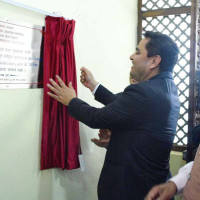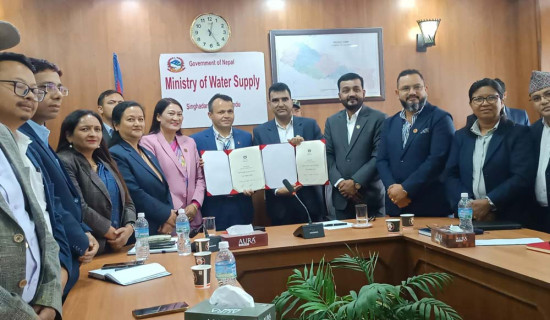- Friday, 9 May 2025
NAST Advances Fuel Cell Technology
Fuel cells, often hailed as the vanguard of sustainable and efficient energy solutions, are finding a new home in Nepal. The Nepal Academy of Science and Technology (NAST) has embarked on an ambitious journey to develop proton exchange membrane fuel cells (PEMFCs) from scratch using locally sourced scrap materials. This pioneering project marks a significant technological breakthrough for Nepal and aligns with global efforts towards greener energy solutions.
Fuel cells convert the chemical energy of hydrogen and oxygen into electrical energy through an electrochemical reaction, with water as the sole byproduct. This clean energy technology includes various types: PEMFCs, Solid Oxide Fuel Cells (SOFCs), Molten Carbonate Fuel Cells (MCFCs), Alkaline Fuel Cells (AFCs), and Direct Methanol Fuel Cells (DMFCs). Each type serves different applications, from transportation to stationary power generation. Their versatility and efficiency make fuel cells an attractive option for countries aiming to reduce their carbon footprint and transition to renewable energy sources.
The concept of fuel cells dates back to 1839, when Sir William Grove first demonstrated this technology. In the 20th century, fuel cells powered space missions like the Apollo programme, providing electricity and water for astronauts. Recent decades have seen significant advancements in materials and efficiency, with countries like the USA, Germany, Japan, and South Korea leading the way.
Fuel cells in Nepal
Nepal, with its unique energy landscape, stands to benefit greatly from adopting fuel cell technology. Fuel cells can reduce Nepal’s dependence on imported oil and petroleum products, conserving foreign exchange reserves and mitigating economic vulnerabilities associated with fluctuating global oil prices. By diversifying energy sources with hydrogen and renewables, Nepal can reduce overdependence on any single source and bolster resilience against supply disruptions. This is crucial for a country heavily reliant on hydropower and vulnerable to seasonal water flow variations. Hydrogen production can utilise excess electricity from renewable sources during peak times, helping to balance the grid and prevent waste. This is particularly beneficial for Nepal, where renewable energy sources like solar and wind can be intermittent and challenging to integrate smoothly into the grid.
Hydrogen can be stored for use during periods of low electricity production, such as the winter months, when Nepal typically imports electricity from India due to minimal hydropower output. This ensures a stable energy supply throughout the year, enhancing energy security and reliability.
Research progress
Different research efforts in Nepal regarding fuel cells primarily focus on assembling and testing already-manufactured fuel cells. However, NAST is unique in its aim to design and develop a fuel cell from the infant stage, making it applicable for practical use. The primary objectives include establishing a state-of-the-art laboratory for PEMFC technology, conducting extensive literature reviews, and sourcing materials locally to minimise costs.
The team has built a simple fuel cell setup using platinum wire and hydrogen produced from the electrolysis of water.
This basic cell can generate a voltage of around 170 mV, and the output has been monitored under different environmental conditions. Initially, experiments were conducted at standard temperature and pressure.
Subsequently, pressure and hydrogen gas flow rates significantly fluctuated, resulting in variations in output voltage. This initial success lays a strong foundation for future advancements and showcases the potential of Nepalese ingenuity in the field of clean energy.
Way forward
In the second phase, NAST plans to design and test a small-scale PEMFC prototype. This phase aims to demonstrate the feasibility of the technology and gather valuable insights for future refinement and scaling.
NAST is trying to apply the electrical energy from the fuel cell to operate small loads like a DC motor, bulb, etc. NAST is also exploring alternatives to platinum, a precious metal used as a catalyst in PEMFCs. Platinum's high cost and scarcity pose significant barriers to the widespread adoption of fuel cells.
Research aims to identify more abundant and cost-effective materials that can perform efficiently in fuel cells, making the technology more accessible and economically viable. The development of hydrogen storage solutions is another priority. Efficient storage is crucial for ensuring a stable hydrogen supply, especially during times of high demand or low production. Innovations in storage technologies aim to create robust infrastructure supporting the growth of hydrogen-based energy systems in Nepal.
(Pandey is a senior technical officer, and Ghimire is an innovation research assistant at NAST.)

















